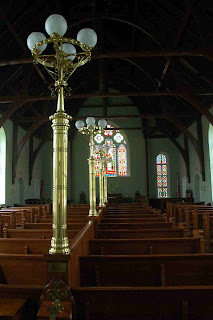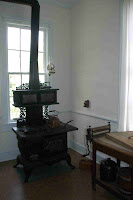I started out the day doing laundry - not that I needed it, since it was only day 5, and I have sufficient clothing to last about 2 weeks, but after 5 days, my laundry bag was getting hard to stuff into the back of my car. I also used the downtime to update my blog.
Historic Pensacola Village
After the laundry, I headed into Pensacola to check out the Historic Pensacola Village, a conglomeration of historic homes, museums, and an old church. I arrived there just after noon, and their next tour (guided tours, which are free with their $6 admission ($5 for AAA), covers 5 of their dozen or so properties). Since I hadn't had much of anything to eat for breakfast, I asked if there was somewhere in walking distance to have lunch. They pointed out a few, then mentioned a place called "The Fish House" that was also nearby. I thought fish sounded good, so I headed over.
 Arriving at the Fish House, it is a bit nondescript, in a stilt building on the water shared by an oyster bar. I climbed up the steps to it, and took a look at their menu. Deciding it sounded good, I went inside, though it was a nice day and they had a patio outside, which I probably should have eaten at. It was somewhat casual outdoors, but inside, it was a really nice place, elegantly decorated, and all the serving staff was well attired.
Arriving at the Fish House, it is a bit nondescript, in a stilt building on the water shared by an oyster bar. I climbed up the steps to it, and took a look at their menu. Deciding it sounded good, I went inside, though it was a nice day and they had a patio outside, which I probably should have eaten at. It was somewhat casual outdoors, but inside, it was a really nice place, elegantly decorated, and all the serving staff was well attired.Initially, I had planned on getting what is usually one of the best values at a seafood restaurant - a fish sandwich. The menu simply described it as "Fish of the Day," and elsewhere listed the "Fish of the Day" as tilapia, salmon, mahi, and grouper. I figured a grouper sandwich for 9.99 is reasonable, so I had planned to order that. After the server told me the day's specials, he informed me of was what I kind of expected might be the case - the sandwich description is not really as it was worded, but rather it's tilapia, and any other fish of the day is a premium cost. I asked about how much the Grouper sandwich would cost, and he said it was a $5 surcharge. I like grouper, but there's no way their cost on it is actually sufficient to make the difference of charging 150% the listed price to upgrade.
Instead, I decided to go with the first special he told me about: Parmesan herb crusted mahi over fried three cheese ravioli, resting on a goat cheese mornay, with sauteed spinach resting on top. For $14 ($1 less than the grouper sandwich), I figured it sounded good. It tasted better than it sounds. I don't normally like cooked spinach. Raw in a salad as part of mixed greens is great, but cooked, not so much. This was some of the best spinach I've had - sauteed in butter, the sauce it created seasoning the mahi and the cheese sauces, it was a great balance. Also, even with the amount of cheeses, and the fried fish and ravioli listed in the description, it was not overly heavy. It had just the right amount of balance between crust and gooey cheesy goodness. Yum! (I must apologize - this was one of the prettiest dishes I've ever eaten, and I had my camera with me, but I completely forgot to take a picture of it when it was served. It only occurred to me that I had forgotten when I had an empty plate, and that doesn't make such a great picture!)
After I finished eating, I went back to the "village," and started exploring some of the "self-guided" homes, like the Manuel Barrios and 1805 Julee cottages until it was time for the tour to start.
The tour started with a British well that was built in the 1770's to protect the city's water supply. The base of the well was constructed with the ballast stones from ships coming to the port, while the top was made mostly of hand made clay bricks.
The tour moved to the 1805 Lavalle house - a home that was originally built as a two-room duplex. All the walls - exterior and interior, were originally filled with load stones from ships that had left them in the Pensacola port. This made the structure extremely solid, but also very heavy. This building and the Julee cottage have both been moved from their original locations, and the Lavalle house underwent a severe diet - shedding most of these load stones, so it could be moved.

The round bowls on the bottom of this table aren't there to make it move across the floor easier - the outer bowl would be filled with water, and the inner bowl would keep the legs o the table dry. This would keep ants from being able to get to the food on the table.
This mold is what it looks like - a baby. Apparently, it was once in fashion to eat baby shaped Jello.
Moving on from the Lavalle house, we went to the 1871 Dorr House. This house is built much later and for a much more wealthy owner. It is a large single family home, featuring Victorian styles, though it is not as ostentatious as the homes I've visited in more affluent cities.
It features a number of examples of hair art - during Victorian times, it was fashionable for ladies to make art and jewelry out of human hair.
 Next on the tour is the 1832 Old Christ Church. This is no longer a church, as the congregation that built it moved to a new church, and took the original stained glass with them. The building was used for a number of purposes before becoming part of the historic village. Under their ownership, the current stained glass featured in the church was from a donor who intended to replace all the side glass as well, but this hasn't happened yet.
Next on the tour is the 1832 Old Christ Church. This is no longer a church, as the congregation that built it moved to a new church, and took the original stained glass with them. The building was used for a number of purposes before becoming part of the historic village. Under their ownership, the current stained glass featured in the church was from a donor who intended to replace all the side glass as well, but this hasn't happened yet. Three of the former reverends of the church were buried under the vestibule. During the Civil War, Union soldiers desecrated their graves in search of valuables, so they were re-interred there under a large marble marker.
Three of the former reverends of the church were buried under the vestibule. During the Civil War, Union soldiers desecrated their graves in search of valuables, so they were re-interred there under a large marble marker.Finally on the tour is the 1890s Lear-Rocheblave House. This is the fanciest of the houses. Built in the late Victorian era, it also features the Victorian styles of architecture and furniture, and shows us a good idea of what the houses of wealthier Pensacolans looked like.
After completing the guided tour, I walked over to the T.T. Wentworth Museum. Along the way, I passed a park that featured some carvings supporting tree branches, and the historic marketplace.
Wentworth was an eccentric collector, who built the museum to display his diverse collection of miscellaneous stuff, as well as Pensacola history.



On the way back to my car, I checked out a couple of the other self-tour buildings in the museum.
National Naval Aviation Museum, Part Deux


Camping at Blakeley State Park
I headed toward Mobile, and along the way, I stopped at a McDonalds and looked up possible camp sites. It was around 8:00, so several of them were closed for the day, but I found an Alabama State Park called Blakeley, gave them a call to verify I could get in, and headed there.
I arrived at Blakeley State Park around 8:30, and shortly into the gate was a ranger's home. He greeted me, took my money, gave me a few pages of information about the park and the camping rules, and told me I could have my pick of whatever site I wanted, but not to explore at night. They had about 35 sites and no other campers. I chose the one closest to the restrooms and the dumpster.
While setting up camp, I had the first casualty of the trip - I broke a tent stake. Fortunately, it was one of the heavy duty extra ones I bought to supplement the ones that came with my tent (which are actually very good, but it's always nice to have extras - for such occasions as this).
After pitching the tent (not throwing it out - it was only a bad stake, after all), I read over some of the history of the park - which made me interested to check it out the next morning, made dinner, then sacked out for the night.






























































































Were you a le to visit Mobile? Apparently it is very rich in French colonial history, as well as it is the true birth of Mardi Gras.
ReplyDelete